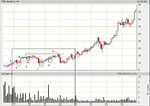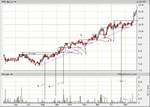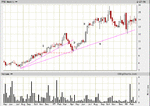barjon
Legendary member
- Messages
- 10,752
- Likes
- 1,863
jo
I think you'd be going some to be thinking of a long entry around the Z point. If you were going to be in, you'd have been in earlier. The X to 2 retracement stopped at around the fib50% which was pretty coincident with the resistance becomes support support line. A fairly safe long entry as the price lifted above the high of the last down bar of the retracement with a stop under that bar's low.(the 3 bar swing I prattled on about earlier would have given an entry here)
As the price reached Z it is around fib50% of the X to 2 down move and I'd have tightened my stop in case it turned round here and the X to 2 retracement became instead the first leg of a reversal downtrend - I certainly wouldn't be thinking of entering long at this point.
That's my take anyway - the more expert may have other ideas!!
good trading
jon
I think you'd be going some to be thinking of a long entry around the Z point. If you were going to be in, you'd have been in earlier. The X to 2 retracement stopped at around the fib50% which was pretty coincident with the resistance becomes support support line. A fairly safe long entry as the price lifted above the high of the last down bar of the retracement with a stop under that bar's low.(the 3 bar swing I prattled on about earlier would have given an entry here)
As the price reached Z it is around fib50% of the X to 2 down move and I'd have tightened my stop in case it turned round here and the X to 2 retracement became instead the first leg of a reversal downtrend - I certainly wouldn't be thinking of entering long at this point.
That's my take anyway - the more expert may have other ideas!!
good trading
jon






